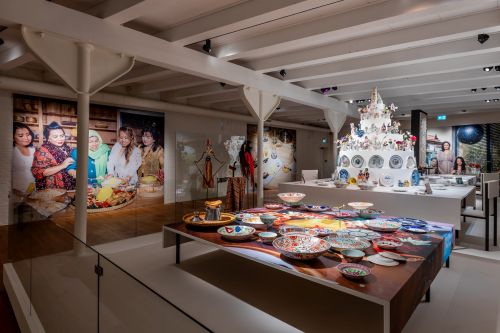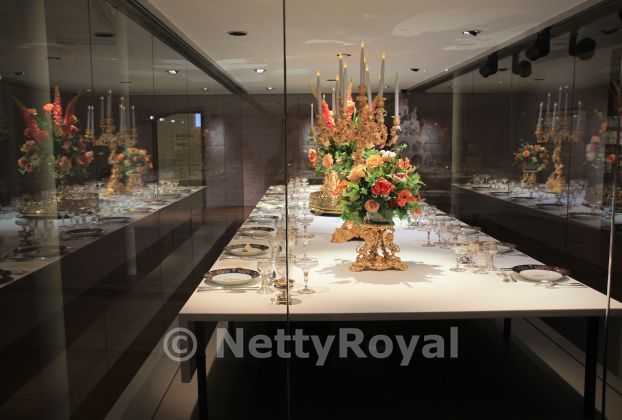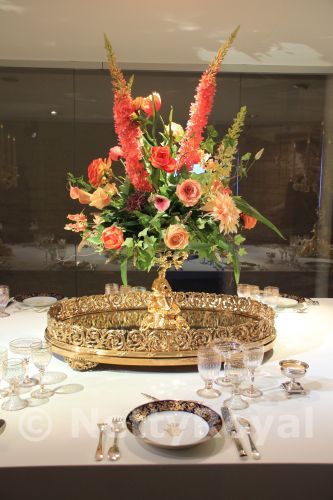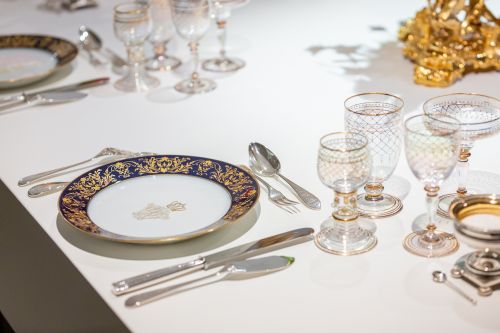Early November I headed for Leeuwarden to see two exhibitions. “Vrijheid, Vetes, Vagevuur” (Freedom, Feuds, Purgatory) at the Fries Museum has several references to nobility, but isn’t specifically about nobles or royals. It deals with the lost world of Tota Frisia in the full and late Middle Ages, when the Frisians were still free people and their territory much bigger than nowadays. To me it was interesting as my ancestors almost all come from the Province of Friesland. The exhibition opened its doors on 10 September 2022 and is open until 7 May 2023. There were also several other nice, small exhibitions to see.


Celebrate! at the Princessehof
However it was the Keramiekmuseum Princessehof, the National Museum of Ceramics, I was actually heading to this time. Their new exhibition opened on 29 October 2022 and is called “Feest! Van Pesach en Ketikoti tot Carnaval en Divali (Celebrate! From Passover and Ketikoti to Carnival and Diwali). The exhibition can be seen until 20 August 2023. The exhibition show how Dutch celebrate through a variety of festive tables, dishes and stories. Based on twelve different celebrations, the Princessehof presents a rich palette of personal, religious and cultural celebrations and commemorations that mark important moments in life. The exhibition features the children’s festival, Lunar New Year, Carnival, Passover, a students’ party, a birthday, a selamatan, a wedding, Eid al-Fitr (Sugar Festival), Ketikoti, Diwali and Christmas.
The exhibition was certainly colourful. Lots of tables, full of tableware in all kind of colours and shapes made me feel quite happy during my visit to the museum. Some cherished items were borrowed from people, many others came from the museum’s depot. A must is the audio guide I think, because partygoers from all over the country, and from all kind of cultures, talk about how they celebrate their traditional feasts. There were however so many stories, that I hardly had enough time to listen to all of them. You can also share your own experiences in an interactive way, by writing on a door to a student’s room or leave your own birthday on a board. There is also a festive photobooth (I guess that is where I had my photo taken) and create a nativity scene, which I must have missed.



Royal table
One of the tables set up in the exhibition is the birthday table of King Willem-Alexander of the Netherlands from 27 April 2017, when he turned 50 and invited 150 people sharing his birthday. The table – in a glass case – is set with a Sèvres-service, cutlery, glasses from the Royal Collection. Unfortunately the video of the King inviting everybody for his birthday was not loud enough to be heard. A few guests that were invited on the occasion tell how they normally celebrate their birthday on 27 April, and how special it is to share the day with the King. You can also try to set a royal table yourself, which even I didn’t dare to. But it was fun to scan the QR-code and see how it should have been done.
Maria Louise was here
After having seen the exhibition and some other parts of the museum I had tea and a petit four to celebrate my museum visit. The delicious petit four was unfortunately also the only thing you could get to eat in the tea room of the museum. Before my visit I therefore I had to go to the other side of the street for lunch.
Upon arrival in the museum I noticed a poster at the entry, which said that the unique light- and sound spectacle “Maria Louise was here” would be shown in the palace gardens for the last time that evening at 8pm. I paid a short visit to my sister before heading to see the show, that was only about 20 minutes long. Although one needed a free ticket, I was able to get in anyway. It was rather special to see the most known inhabitant of the former Princessehof Palace – or rather actress Ariane Schluter – projected on the walls of the building.
The show was directed by Jos van Kan. The media artist Frouke ten Velden created the images, while Max Knigge composed the music, played by the Noord Nederlands Orkest. Although I know something about Maria Louise, born a princess von Hessen-Kassel and the wife of Stadtholder Johan Willem Friso, I found it quite hard to actually follow the story from her arrival at the palace to her death. So I mainly took it as a light and sound show.
Book
For people interested there is a hand-out booklet that you have to give back at the end of the tour, or buy after having visited the exhibition. There is also another book available, called “Kunst en koken. Kookboek Keramiekmuseum Princessehof” (Art and Cooking. Cookbook The Princessehof National Museum of Ceramics), published both in Dutch and in English. More than 400 pages combine ceramic and culinary art.
For the book, 45 masterpieces from Asia, the Middle East and Europe were selected from the Princessehof’s collections. They are shown in the book with photos and background stories. The book alo features dozens of unique recipes by nationally and internationally renowned chefs, culinary writers, bakers and other foodies, that were created especially for the tableware from the collections of the museum.
If you become a friend of the Princessehof before 1 December 2022 you will receive the cookbook as your welcome present. Otherwise the book by Karin Gaillard, Eline van den Berg and Teuntje Klinkenberg costs € 49.95, and surprisingly a bit less when buying it in Germany or France.

Dear Netty:
It has been many years since you wrote about the royalty. Your website is special as you personally visit/visited different places and cover/covered the royal news.
Bravo!